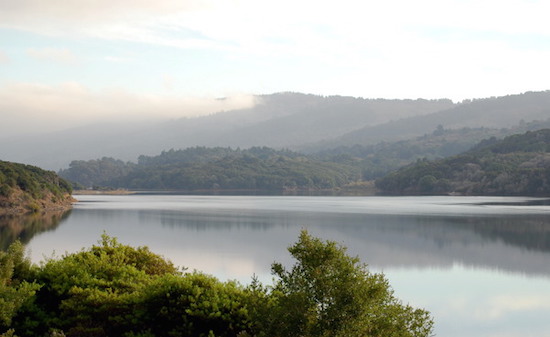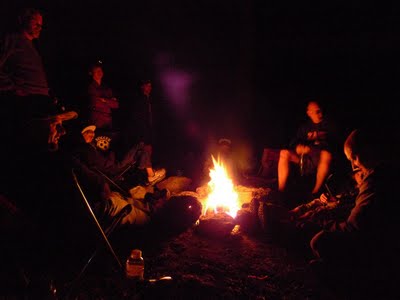
Water and Fire
These essays are now also available in book form, printed on real paper

Crystal Springs Reservoir is an artificial lake that sits on the San Andreas Fault between San Francisco and San Jose. It is one of the more beautiful reservoirs I know of, and there are lots of pretty views along the lake. Nevertheless, you’ve got to work hard to snap a picture that doesn’t show barbed wire between the camera and the water.
The reservoir is primarily filled from pipes that come from the Hetch Hetchy Reservoir in Yosemite, famous for the valley of the same name that was destroyed—er, utilized—by the San Francisco Water Department when it was flooded in the early 20th century to provide water for the city. John Muir mourned the loss of Hetch Hetchy Valley, which he compared to Yosemite Valley in beauty (Muir suggested that the governement might as well seal up cathedrals and churches for water tanks while they were at it). But Crystal Springs is a beautiful expanse of water in a beautiful area minutes from Silicon Valley, and beggars can’t be choosers.
As a suburbanite living in an overcrowded metropolitan area, I am sometimes surprised to be reminded that I am surrounded by water. Yes I can get to the Pacific Ocean in about 40 minutes, but though the San Francisco Bay is even closer, and there are natural creeks and streams everywhere, water is hard to find; hidden under concrete and usually only seen–but just barely–from bridges. I used to live in Redwood City, and it wasn’t until I’d been there for several years that I learned that there used to be canals–canals!–running right into the downtown area. While boats had once docked a hundred yards from the beautiful county courthouse, now you can stand where schooners once floated and not even know that water still flows somewhere underneath your feet.
My heart broke when I learned that I could have walked along canals in the center of this old, interesting town, instead of along a loud, car-filled street. I know why they covered them up. Ships stopped contributing significantly to the economy, and the creek feeding the area was too much work to dredge. Add to that the increase in automobile traffic and the economic potential of more streets and better traffic management, and you can see the logic of paving over nature, which has a way of getting in the way of progress. When the creek went underground, something was gained and something was lost. I don’t always root for the losing team (my mom and my wife do that), but in this case I’m crying in my beer.
Thankfully you can still get to the remaining wet places in the area, but you have to get out of your car to see them (the scene above is only visible from the car-free Sawyer Camp Trail), and that means that most people won’t see them. You can drive over any number of bridges that span the Bay, and hardly see the water at all. This will be partly because of the railings and traffic that block your view, and partly because if you do try to take in the view, you’ll probably crash your car, which might give you more time to look at the view, but behind you will be the drivers of many cars who are now looking at the view instead of driving to wherever it is they want to go, and they will hate you. Nobody likes to be forced to appreciate nature.
You need to get out of your car. Looking at water from inside a car (a parked car, please) is like watching the nature channel–you can’t really experience water through the window of your car. You might as well watch it on TV. You need to get close. You need to listen to water as it washes over the sand and as waves slap against the rocks. You have to get close to hear the sounds of water as it tumbles over rapids in a stream, echoing off the leaves of shade trees. You need to be able to watch the surface of the water move (impossible, if you are moving yourself–you have to stop). This is another one of those almost forgotten things that causes my skin to tingle when I experience it after a long time of deprivation.
Fire has also been caged and hidden. For most of us metro-unfortunates, the only fire that burns in our houses is safely hidden from view in steel boxes where our water or our air or our chicken nuggets are heated (that is if we still cook with the box that uses heat waves and haven’t given it up for the one that uses electromagnetic waves). For those of us in old homes that still have fireplaces, we are told by the law that we can’t burn wood on certain days, because then all the drivers would have to roll up their windows to keep from smelling the air we thoughtlessly smoked up. The air we smoked up by burning wood, another natural thing that is being outlawed while we continue to pursue happiness in cars.
Now I know, because I am reminded constantly, that these days any smoke adds to the danger in an already dangerously overcrowded region. I once heard that the Los Angeles basin has always had a natural inversion-layer and that Southern California air quality was a problem even when the only smoke rose from the fires of Native camps. I guess some places were never capable of naturally supporting large populations no matter how they cooked their food or got to work.
And I know that these days I have a choice: I don’t need to burn wood to stay warm or cook my food. Even if I want to barbecue, I’m told, I should get a gas grill because it is more eco-sensitive. Better to burn gas under the food I eat: better for the food (less carcinogenic, I’m told) better for the air (less particulates in the smoke), more convenient (Quicker! Cleaner!). If I miss the smoky flavor of charcoal, I can add it to the meat before I barbecue (Smoke in a Bottle! That’s green.)
And I know that these days 99% of the population have no choices when it comes to commuting: they have to drive to work, or think that they have to. The society is set up for cars.
I know these things. But I will never, ever be comfortable with the idea that because so many people burn gas in their vehicles to get to work, they should then come home and use gas to cook their burgers instead of charcoal. How did burning petrochemicals in a barbecue become part of the green solution to an air quality problem caused by the burning of petrochemicals?
We have candles in our fireplace now. It’s pretty I guess. We don’t need the fireplace to warm the house, so it works out. It’s better for the air: kids and adults with breathing-related illnesses like asthma will breathe easier. That’s a win. But something has been lost too. The sights and sounds of a wood fire in a house are emblematic of home, shelter, comfort: the sound of fire, almost like banners moving in stiff wind, with the occasionally snap or pop that makes you jump and check the floor for sparks; the sight of fire, intensity of color, flames rippling, also like banners, trapped in their own thermals. Move in close, as close as possible, to stare at the embers. It’s like looking into a volcano in miniature, as close as I’ll ever get.
Will California broadcasters ever realize that most of their audience is now in the same boat as New York apartment-dwellers and put a yule log on the TV at Christmas time? Oh, I forgot, we are allowed to put gas fireplaces in our new homes, which is kind like the TV yule log already, with the following differences: 1) you still get the pleasure of lighting your “fire”; 2) it doesn’t come into the home over the air, but through pipes; and 3) it still produces some heat and exhaust gasses. If I had to choose one over the other, I don’t know which is worse for the planet. But for my money, if the gas fire is burning behind glass, I figure I’ll just go with the TV, and turn up the heat.
Image of Crystal Springs Reservoir from Wikimedia Commons, by user Kglavin

